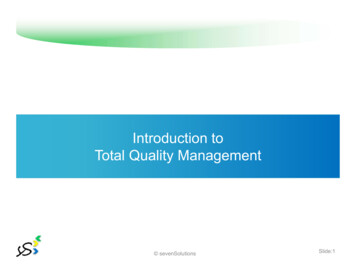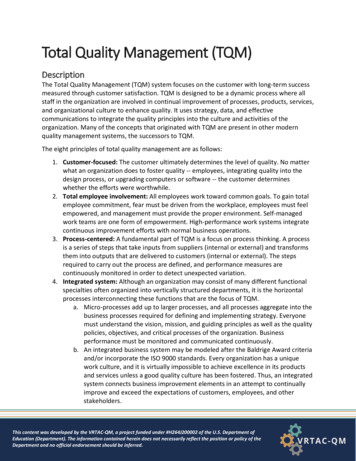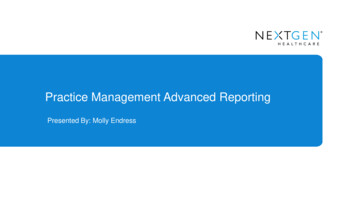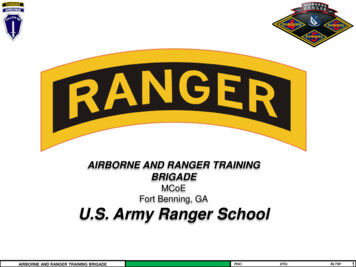
Transcription
Introduction toTotal Quality Management sevenSolutionsSlide:1
Index1. Introduction to TQM2. Need and Applicability of TQM3. Key Elements of TQM4. TQM and Six Sigma sevenSolutionsSlide:2
Other Definitions for Quality The concept and vocabulary of quality are elusive. Different peopleinterpret quality differently. Few can define quality in measurableterms that can be proved operationalize.The American National Standards Institute (ANSI) and theAmerican Society for Quality (ASQ) define quality as:“The totality of features and characteristics of a product or servicethat bears on its ability to satisfy given needs.”Quality is Fitness for Use.Evaluates performance for intended use Quality is customer satisfaction and loyalty. sevenSolutionsSlide:3
Introduction What is a customer?Anyone who is impacted by the product or process delivered by anorganization.External customer: The end user as well as intermediate processors. Otherexternal customers may not be purchasers but may have some connectionwith the product.Internal customer: Other divisions of the company that receive the processedproduct. What is a product?The output of the process carried out by the organization. It may be goods(e.g. automobiles, missile), software (e.g. a computer code, a report) orservice (e.g. banking, insurance)4 sevenSolutions
Introduction How is customer satisfaction achieved?Two dimensions: Product features and Freedom from deficiencies. Product features – Refers to quality of design.Examples in manufacturing industry: Performance, Reliability,Durability, Ease of use, Esthetics etc.Examples in service industry: Accuracy, Timeliness, Friendlinessand courtesy, Knowledge of server etc. Freedom from deficiencies – Refers to quality of conformance.Higher conformance means fewer complaints and increasedcustomer satisfaction.5 sevenSolutions
History of quality management To know the future, know the past! Before Industrial Revolution, skilled craftsmen served both asmanufacturers and inspectors, building quality into their productsthrough their considerable pride in their workmanship.Industrial Revolution changed this basic concept to interchangeableparts. Likes of Thomas Jefferson and F. W. Taylor (“scientificmanagement” fame) emphasized on production efficiency anddecomposed jobs into smaller work tasks. Holistic nature ofmanufacturing rejected!6 sevenSolutions
History of quality management Statistical approaches to quality control started at Western Electricwith the separation of inspection division. Pioneers like WalterShewhart, George Edwards, W. Edwards Deming and Joseph M.Juran were all employees of Western Electric.After World War II, under General MacArthur's Japan rebuildingplan, Deming and Juran went to Japan.Deming and Juran introduced statistical quality control theory toJapanese industry.The difference between approaches to quality in USA and Japan:Deming and Juran were able to convince the top managers theimportance of quality.7 sevenSolutions
History of quality management Next 20 odd years, when top managers in USA focused onmarketing, production quantity and financial performance, Japanesemanagers improved quality at an unprecedented rate. Market started preferring Japanese products and Americancompanies suffered immensely. America woke up to the quality revolution in early 1980s. FordMotor Company consulted Dr. Deming to help transform itsoperations.(By then, 80-year-old Deming was virtually unknown in USA.Whereas Japanese government had instituted The Deming Prize forQuality in 1950.)8 sevenSolutions
History of quality management Managers started to realize that “quality of management” is moreimportant than “management of quality.” Birth of the term TotalQuality Management (TQM).TQM – Integration of quality principles into organization’smanagement systems.Early 1990s: Quality management principles started finding theirway in service industry. FedEx, The Ritz-Carton Hotel Companywere the quality leaders.TQM recognized worldwide: Countries like Korea, India, Spain andBrazil are mounting efforts to increase quality awareness.9 sevenSolutions
Commonality of Themes of Quality Gurus Inspection is never the answer to quality improvement, nor is“policing”. Involvement of leadership and top management is essential tothe necessary culture of commitment to quality. A program for quality requires organization-wide efforts andlong term commitment, accompanied by the necessaryinvestment in training. sevenSolutions
TQM vs. Other Quality ToolsISO for example has different standards for different purposes, for security management, forproduct quality etc. Implementing ISO involves going through certain guided principles toensure that correct approach is taken while rendering services with lesser effort to focus onthe final product.ITIL (Information Technology Infrastructure Library) is a set of standards for quality.However, they are applicable to IT related products and services only.COPC (Customer Operations Performance Centre) CSP (Customer Service Provider) andVMO (Vendor Management Organization) are quality standards specifically designed for theprocesses that are outsourced to a call centre and for the call centre itself.Six Sigma is used when either there is a defect in existing process or we want process toperform at a higher performance level. So, the approach, is limited to thedepartments/persons/processes involved in the process and at end. It has a definiteproblem statement and a defined solution. sevenSolutionsSlide:11
TQM vs. Other Quality ToolsTQM is an effective System of Quality Development, Quality Maintenance and Qualityimprovement efforts involving all the departments and groups in an organization to alloweconomy in production of goods or rendering of services along with complete customersatisfaction. sevenSolutionsSlide:12
Ingredients of TQMTQM is an effective System of Quality Development, Quality Maintenance and Qualityimprovement efforts involving all the departments and groups in an organization to alloweconomy in production of goods or rendering of services along with complete customersatisfaction.So, the basic ingredients of TQM are:Quality of Products or Processes is responsibility of all involved in the creation andcustomer (internal and external).Aimed at Economy in the cost levelAimed at Satisfaction at the customer level sevenSolutionsSlide:13
Index1.Introduction to TQM 2.Need and Applicability of TQM3.Key Elements of TQM4.TQM and Six Sigma sevenSolutionsSlide:14
Index1. Introduction to TQM 2. Need and Applicability of TQM3. Key Elements of TQM4. TQM and Six Sigma sevenSolutionsSlide:15
Applicability of TQMEngineersTotal Quality Management covers all aspects from Top DownMaintenanceandHelps optimize cost, revenue and ensures CustomersatisfactionFinanceCommunications/BPO sevenSolutionsSlide:16
Need of TQMThe need of TQM lies in the fact that it is Quality tool that can be:1. Implemented over a larger area2. Always the end result aimed at Customer or End User satisfaction3. All Process from Conceiving Idea to Earning Revenue is taken care of4. Aims are Long Term Success5. Caters to ManufacturingProcess that is more dynamicEngineers6. Creates Accountability in each entityMaintenanceFinanceCommunications/BPO sevenSolutionsSlide:17
Relationship between TQM, JIT & TPMTotal Quality Management has a close relationship between the below two Quality ParametersJIT – Just in TimeJIT is a manufacturing Program to identify and eliminate all kinds of wastethrough Just in Time production and involvement of workforce. Two majorwastes are WIP inventory and unnecessary delay in flow time.Implementation methodology are Set up time reduction and Pull Systemproduction.TPM – Total Productive MaintenanceJITTQMTPMTPM is a manufacturing Program designed to maximise equipmenteffectiveness, throughout its entire life through the participation andmotivation of entire workforce.TQM – Total Quality Management includes the below in light of JIT and TPMTQM basic techniques include cross-functional product design, process management,supplier quality management, and customer involvement.JIT basic techniques include set-up time reduction, pull systems production, JIT deliveryby suppliers, equipment layout, and daily schedule adherence.TPM basic practices are autonomous and planned maintenance, technology emphasisand proprietary equipment development. sevenSolutionsSlide:18
Index1. Introduction to TQM 2. Need and Applicability of TQM 3. Key Elements of TQM4. TQM and Six Sigma sevenSolutionsSlide:19
Index1. Introduction to TQM 2. Need and Applicability of TQM 3. Key Elements of TQM4. TQM and Six Sigma sevenSolutionsSlide:20
OthersIntl Quality Std.TechnologyMarketHealthEnvironmentSocial AspectsLegislationKey Elements of TQM – TQM Structure in the Org.Quality StandardsInput‐ Supplier‐ ResourcesBusiness ProcessOutput‐ Quality‐ Cost‐ Delivery‐ ServiceCustomer (Int./Ext.) Satisfaction sevenSolutionsSlide:21
TQM Structure in the Org.Management plans the activitiesfor TQM facilitationDifferent applicable QualityStandards are integrated into theProcess and OperationThe Quality Standards ensureSupply Chain Managementto be correct and smoothThe Quality Standards also ensurethe final product to be as percustomer requirement or betterCorrect inflow and outflow ofservices and products keepcustomers satisfiedSo, overall Operation runs on its Optimum Capacity always,so that Cost, Revenue and Customer Satisfactionare always on minimum defect level sevenSolutionsSlide:22
Cost - Money - Price Money – The language of management sevenSolutions
ConceptThe "cost of quality" is not the price of creating aquality product or service.It's the cost of NOT creating a quality product orservice. sevenSolutions
COQ - Definitionis a means to quantify the totalcost of: Quality‐related effortsand DeficienciesQuality costs are the costs associated with Preventing Investing in the prevention ofnonconformance to requirements Finding . Appraising a product or servicefor conformance to requirements Failing to meet requirements .Correctingdefective work sevenSolutions
COQ Components Preventive CostThe costs of all activities specificallydesigned to prevent poor quality inproducts or services.Examples are the costs of: New product review Quality planning Supplier capability surveys Quality improvement teammeetings Quality improvement projects Quality education and training In the ideal situation, Prevention costs will be the largest portion ofthe Total Cost of Quality Typically, prevention is less than 10% of Total COQ where it should beabout 70% sevenSolutions
COQ Components Appraisal CostThe costs associated with measuring,evaluating or auditing products orservices to assure conformance tostandards & performance requirements.These include the costs of: Inspection/test of purchased material In‐process and final inspection/test Product, process or service audits Calibration of measuring and test equipment sevenSolutions
COQ Components Failure CostsThe costs resulting from products orservices not conforming torequirements or customer/userneeds. Failure costs are divided intointernal and external failurecategories.Internal Failure CostsFailure costs occurring prior to delivery or shipmentof the product, or the furnishing of a service, to thecustomer.Examples are the costs of: Scrap Rework sevenSolutions Re‐inspection Re‐testing
COQ Components Failure Costs (Contd.) External Failure CostsFailure costs occurring after delivery or shipment of theproduct — and during or after furnishing of a service —to the customer.Examples are the costs of: Processing customer complaints Customer returns Warranty claims Product recalls sevenSolutions
Size of various quality cost elementsQuality costs in % of sales10‐15%10‐12%The total qualitycosts 25‐35 %of e sevenSolutionsExternalFailure
Impact of TQM on costs.ã TQM is primarily aimed to improve the quality of the product , highercustomer satisfaction and better working environment for theemployees. The most dramatic impact of TQM is on reduction ofquality costs which directly effect the profitability .ã This is demonstrated by the results of TQM program in Xerox Corp .The change in various elements of quality cost before and afterlaunching TQM by Xerox Corp is shown on the next slide. sevenSolutions
Impact of TQM on costs.An example from Xerox Corp.3530% of alAppraisal50PreventionpreventionAfter TQMBefore TQM sevenSolutions
Why measure COQ?Measure COQ ‐ Why? COQ can be used to identify quality improvementcandidates COQ provides one measure of comparing thesuccess of projects COQ can provide cost data for motivationalpurpose Money is the language of management, youneed to show them the numbers ‐ Crosby sevenSolutions
Steps in implementing TQM sevenSolutions
TQMThe implementation of TQM its impact on manufacturing performanceThey derived 16 Principles which are essential elements of nctional Product DesignProcess ManagementSupplier Quality ManagementCustomer InvolvementInformation and FeedbackCommitted LeadershipStrategic PlanningCross-Functional TrainingEmployee InvolvementSet-up time reductionPull System ProductionDelivery by SuppliesEquipment LayoutDaily Schedule AdherenceAutonomous & Planned MaintenanceTechnology Emphasis sevenSolutionsSlide:35
The implementation of TQM its impact on manufacturing performance.They derived 16 Principles which are essential elements of unctional Product DesignProcess ManagementSupplier Quality ManagementCustomer InvolvementInformation and FeedbackCommitted LeadershipStrategic PlanningCross-Functional TrainingEmployee InvolvementSet-up time reductionPull System ProductionDelivery by SuppliesEquipment LayoutDaily Schedule AdherenceAutonomous & Planned MaintenanceTechnology Emphasis sevenSolutionsSlide:36
TQM for Top Management1-Strategic Quality Management (SQM).Vision/Mission statementQuality policies.Quality goalsMeasurement feedbackReview of progressTraining sevenSolutions
– Strategic PlanningStrategy or Policies are made at the uppermost levels of Leadership. TQM wants that there should be aStrategic Plan for the organization which is clear and motivated. Generally an organizations strategyrevolves around its Vision and Mission.With a clear strategy, it is easy for the Management, Manufacturing Plant and other departments todevelop their own pointers to drive towards the common goal.This requires a methodical approach, that is TQM or any other Quality initiative.The advantages are:1.Goal is defined2.Misinterpretation of Key deliverables are avoided3.Larger goal of the organization makes the smallermissions well defined and time bound4.Leadership’s ease of maneuvering the teams andmanagement is increased towards the Vision sevenSolutionsSlide:38
TQM for Middle Management1-Process ManagementPlanning and administrating the activities necessary to achievehigh quality in business processes; and also identifyingopportunities for improving quality and operational performance– ultimately, customer satisfaction. Processes are of two types – value-added processes andsupport processes. Value-added processes – those essential for running thebusiness and achieving and maintaining competitiveadvantage. (Design process, Production/Delivery process). Support processes – Those that are important to anorganization’s value-creation processes, employees and dailyoperations. Value creation processes are driven by external customerneeds while support processes are driven by internal needs. sevenSolutions
Process Management (TQM)Process management is the application of knowledge, skills, tools, techniques and systems.Its primary motive is to define, visualize, measure, control, report and improve processes.The goal of PM is to meet customer requirements profitably.It is also called BPM (Business Process Management)The advantages are:1.Processes are defined as per QualityParameters and has defined SOPs2.It is an ongoing Process, and helps to keeppace with the market change and demand3.Defects are minimized, Cost and RevenueOptimized and Customer SatisfactionMaximized. sevenSolutionsSlide:40
2-Statistical Process Control (SPC).Statistics and probabilityConfidence interval.Control chartMil standardQuality tools sevenSolutionsSlide:41
Use the Tools of TQM sevenSolutions
sevenSolutions
Pareto Chart - ranked histogram Invented by Joseph JuranBeer unky sevenSolutionsMiscDefects
Wilfredo Pareto 1848-1923 Italian Economist “80/20” rule: 80% of the wealth iscontrolled by 20% of the peopleCours d'économie politique (18967) 80/20 rule believed to apply muchmore widely 1906- “Pareto Optimality” – notpossible to make anyone better off(in his own estimation) withoutmaking someone else worse off sevenSolutions
Cause & Effect Diagram ExampleToo ManyDefects sevenSolutions
Cause & Effect Diagram ExampleMethodManpowerMain CauseToo ManyDefectsMaterialMachineryMain Cause sevenSolutions
Cause & Effect Diagram ExampleMethodManpowerDrillTiredToo ManyDefectsWoodSteelMaterialLatheMachinery sevenSolutions
Cause & Effect Diagram ExampleMethodDrillManpowerOverTimeSlowTiredWoodNot driedMaterialToo ManyDefectsNotmaintainedSteelLatheMachinery sevenSolutions
Control Chart Example70X60UCL50403020LCL100123456Time7 sevenSolutions89101112
Checklist Simple data check-off sheet designed to identifytype of quality problems at each work station; pershift, per machine, per operator51 sevenSolutions
Histograms A chart that shows the frequency distribution ofobserved values of a variable like service timeat a bank drive-up window Displays whether the distribution is symmetrical(normal) or skewed52 sevenSolutions
Scatter diagrams Graphical components of the regression analysis.Often used to point out relationship between variables. Statistical correlationanalysis used to interpret scatter diagrams.53 sevenSolutions
Flow chart sevenSolutions
3 – Cross-Functional Product Design (TQM)Cross-functional product design is a widely used method for involving different functional areas in newproduct/process development.It is used when either an existing product has to under go change or a new product is planned orconceived to be launched.The advantages are:1.Previous Experience are used2.Buy in of all departments ensures minimumresistance and ease in change management3.All factors, including Finance, Engineering,Maintenance, Marketing, Operations etc. are takencare of4.Sustainability of the Product increases5.Any setback in future is handled with plannedprocedures sevenSolutionsCross FunctionalInteractionSlide:55
3 – Cross-Functional Product Design (TQM)The Cross-Functional Product Design should be measured to eliminate chances of a Product design orre-design to miss out on inputs of any Function and to ensure, it is adhered to, at first place.The advantages are :1.Direct labour employees are involved to a great extent (onteams or consulted) before introducing new products ormaking product changes.2.Manufacturing are involved to a great extent before theintroduction of new products.3.Design is conceived in teams, with members from a varietyof areas(marketing, manufacturing, etc.) to introduce new products.4.The time to introduce new products is reduced by designingproduct and process together. sevenSolutionsCross FunctionalInteractionSlide:56
3 – Supplier Quality Management (TQM)Supplier Quality Management ensures that the supplier of raw materials is certified for Quality, exampleISO certified. Or the Organization has its own Quality check mechanism that has certified the Supplier.Management Guru’s have created a separate chain called SCM (Supply Chain Management)that studies the efforts in improving the standards and maintaining the high standards of Supplier so thatthe basic input to the Process Management is flawless and optimized.The advantages are:1.Quality of raw materials are ensured.2.Timely delivery is ensured.3.Cost effective inventory management can bedone.4.Supplier back up ensure least disruption inproduction5.Competitive price can be negotiated sevenSolutionsSlide:57
TQM for the Workforce-Kaizen teams-An intense and rapid improvement process in which a team or adepartment throws all its resources into an improvement project over ashort period of time.-Blitz teamsusually comprise of employees from all areas involved in the process whounderstand it and can implement the changes on the spot.-Quality CirclesTeams of workers and supervisors that meet regularly to address workrelated problems involving quality and productivity.Typically small day-to-day problems are given to quality circles. Sinceworkers are most familiar with the routine tasks, they are asked toidentify, analyze and solve quality problems in the routine processes. sevenSolutions
Employee InvolvementAs per the name, it simply means that the employees are involved in problem solving and getting aroundissues that may or are cause of production to go down or stop. Employee Involvement ensures that thesolution derived has the accent of employees and any issue faced by the employees in the productionare addressed automatically.The advantages are:1.Less Negative turnover2.Skill bank enhancement3.Increase in accountability of employees due to beingengaged in problem solving and product design4.Solutioning is fast due to prior knowledge of productengineering and quality enhancement sevenSolutionsSlide:59
Index1. Introduction to TQM 2. Need and Applicability of TQM 3. Key Elements of TQM 4. TQM and Six Sigma sevenSolutionsSlide:60
Index1. Introduction to TQM 2. Need and Applicability of TQM 3. Key Elements of TQM 4. TQM and Six Sigma sevenSolutionsSlide:61
TQM and Six SigmaTQM is a Framework of Principles and Systems Approach. All nine Elements we discussed for TQM,there are few which can use Six Sigma as a method of usage. Generally, a Six Sigma approach coversone or more areas of TQM ElementsAs per Philip Crosby:Pre-determined requirements, design activities and manufacturing practices are the basisof quality product and quality definition with be ‘conformance to requirement’. Thisdefinition ensures zero defect product as 100% conformance to requirement is the onlyacceptable quality measure. So it is Management’s responsibility to create correctrequirements.As per Joseph M. Juran:Quality is the final product being in ‘conformance to specifications’ or ‘conformance tostandards’. However, in terms of manufacturing, this definition is not accurate to T becauseat a Managerial Level, conformance to specification is only one of the many means toreach at end product that is 100% defect free. sevenSolutionsSlide:62
Six sigma is a business statistical Strategy. Is to identifying defects and removing them fromthe process of products to improve quality. A defect is defined as any process output thatdoes not meet customer specifications. Statistical measure to objectively evaluateprocesses. sevenSolutions
Quality management program developed by Motorola in the 1980s.Management philosophy focused on business process improvements to: Eliminate waste, rework, and mistakes Increase customer satisfaction Increase profitability andcompetitiveness sevenSolutions
The Six sigma was founded by Motorola in the1970s. Out of senior executive Art Sundry's criticism ofMotorola’s bad quality. They founded a connection between increasesin quality and decreases in costs of production. Bill Smith, “Father of six sigma” introduce thisquality improvement Methodology to Motorola. sevenSolutions
Six Sigma Lean ManufacturingGoalApproachBenefitsSix SigmaLeanImprove qualityReduced wasteFocus on part of ProcessHolistic view of processReduce defects,Increase Capability &Productivity1stReduced VariationProcessEffective sevenSolutionsReduce lead Time,Increase Capacity &Lower Inventory2ndImproved FlowEfficient
sevenSolutions
SPECIFICATION BOXESRelated to SPC and Process Variation12PROCESS IS OUTSIDE OFTHE SPECIFICATION LIMITSPROCESS IS W ITHIN THESPECIFICATION LIMITS,BUT THERE IS STILL LARGEVARIATION3PROCESS IS STILL W ITHINTHE SPECIFICATION LIMITSAND VARIATION HAS BEENFURTHER REDUCED25A Specification is a document that contains requirements for a product or a service! sevenSolutions
TQM System ApproachQuality Planning starts fromLeadership, enforced byManagement and Implemented bywork forceQuality Control is specific tothe Center of Excellence ofQC and forms major part ofRoutine Quality JobQuality Improvement is a Cycle in which allDepartments and Individuals play equallyimportant role sevenSolutionsSlide:69
COMPANY THATPRACTICES TQM sevenSolutions
FORD Motor Companyo Is an American multinational automaker based in Dearborn,Michigan, a suburb of Detroit. The automaker was foundedby Henry Ford and incorporated on June 16, 1903.o Ford is the second largest automaker in the U.S. and the fifth‐largest in the world based on annual vehicle sales in 2010. At theend of 2010, Ford was the fifth largest automaker in Europe. Fordis the eighth‐ranked overall American‐based company in the2010 Fortune 500 list, based on global revenues in 2009 of 118.3 billion. sevenSolutions
TQM techniques that Ford used:Six Sigmao Quality Operating System or (QOS)o developed their own quality process or 5S.o The DMAIC process, or define, measure, analyze, improve, andcontrol has built an overall strategy for consistency in their teams,o sevenSolutions
XEROX Xerox has established a program called Leadership Through Quality (LTQ)and a Quality Training Task Force for its company’s leadership teams."Today, more than 100,000 Xerox employees worldwide have been trainedin this process, which stresses continuous improvement and defines qualityprecisely as meeting customer requirements" (Evans-Correia, 1997, 135). sevenSolutions
The XEROX Corporation focuses on:oooBenchmarkinga reduced supplier baseand leadership teams sevenSolutions
sevenSolutions
Index1. Introduction to TQM 2. Need and Applicability of TQM 3. Key Elements of TQM 4. TQM and Six Sigma sevenSolutionsSlide:76
Managers started to realize that “quality of management” is more important than “management of quality.” Birth of the term Total Quality Management (TQM). TQM – Integration of quality principles into organization’s management systems. Early 1990s: Quality management principles










